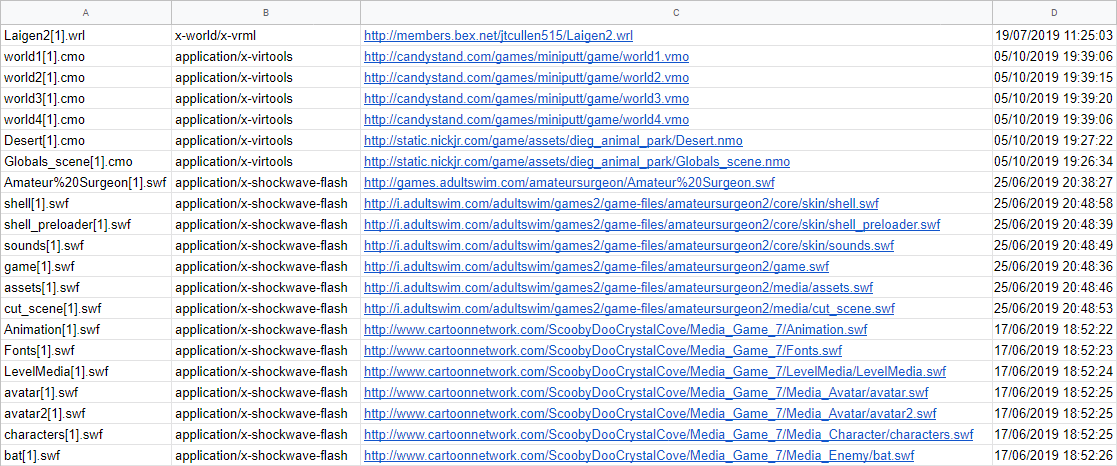Recovering Files from Browser Cache: Difference between revisions
mNo edit summary |
mNo edit summary |
||
| Line 288: | Line 288: | ||
** Added support for Windows 98 and ME. To run this tool in those versions, use <code>Win-98-ME-FlashpointCacheDumper.bat</code> and <code>Win-98-ME-CompleteFlashpointCacheDumper.bat</code> instead. | ** Added support for Windows 98 and ME. To run this tool in those versions, use <code>Win-98-ME-FlashpointCacheDumper.bat</code> and <code>Win-98-ME-CompleteFlashpointCacheDumper.bat</code> instead. | ||
** Added support for Netscape Navigator 3.x through 9.x. These cached files are saved to <code>RawNetscapeNavigatorCache.7z</code>. | ** Added support for Netscape Navigator 3.x through 9.x. These cached files are saved to <code>RawNetscapeNavigatorCache.7z</code>. | ||
** Updated the README with instructions on how to analyze the resulting files | ** Updated the README with instructions on how to analyze the resulting files and other ways of exploring the cache. | ||
** The batch files now save more information to <code>RawInternetExplorerCache.csv</code> (renamed from <code>RawInternetExplorerCache.txt</code>). This was done by including [https://www.nirsoft.net/utils/search_my_files.html NirSoft's SearchMyFiles], which is located in <code>App\searchmyfiles</code>. | ** The batch files now save more information to <code>RawInternetExplorerCache.csv</code> (renamed from <code>RawInternetExplorerCache.txt</code>). This was done by including [https://www.nirsoft.net/utils/search_my_files.html NirSoft's SearchMyFiles], which is located in <code>App\searchmyfiles</code>. | ||
** Added a new cache viewer called [http://www.progsoc.uts.edu.au/~timj/cv/ Tim Johnson's Cache View]. This tool can be used to load Netscape Navigator's cache, and is located in <code>App\cview285</code>. | ** Added a new cache viewer called [http://www.progsoc.uts.edu.au/~timj/cv/ Tim Johnson's Cache View]. This tool can be used to load Netscape Navigator's cache, and is located in <code>App\cview285</code>. | ||
** The <code>SystemInfo.txt</code> file now also saves which batch file was used, and the date when it ran. | ** The <code>SystemInfo.txt</code> file now also saves which batch file was used, and the date when it ran. | ||
** Renamed <code>ContentTypesToSave.txt</code> and <code>URLsToSave.txt</code> to <code>MimeTypesToSave.txt</code> and <code>WebsitesToSave.txt</code>, respectively. | ** Renamed <code>ContentTypesToSave.txt</code> and <code>URLsToSave.txt</code> to <code>MimeTypesToSave.txt</code> and <code>WebsitesToSave.txt</code>, respectively. | ||
** Added Atomic3D Player and Pulse Player's MIME types and file extensions to <code>MimeTypesToSave.txt</code>. Also added some missing ones for Authorware, Hypercosm 3D Player, Java, Silverlight, Viscape, and VRML. | ** Added Atomic3D Player and Pulse Player's MIME types and file extensions to <code>MimeTypesToSave.txt</code> and <code>FileExtensionsToSave.txt</code>. Also added some missing ones for Authorware, Hypercosm 3D Player, Java, Silverlight, Viscape, and VRML. | ||
** Added more websites to <code>WebsitesToSave.txt</code> and categorized any previously unsorted domains. | ** Added more websites to <code>WebsitesToSave.txt</code> and categorized any previously unsorted domains. | ||
** Fixed the batch files not being able to execute basic commands if the PATH environment variable didn't include Windows' system directories. | ** Fixed the batch files not being able to execute basic commands if the PATH environment variable didn't include Windows' system directories. | ||
Revision as of 02:08, 27 April 2020
Web browsers often save files from websites you visit in a location called the "cache". This speeds up page loading times on subsequent visits because the cached files do not have to be redownloaded. We can use this to our advantage when looking for web games whose files are now unavailable.
This method for finding assets belonging to lost games is imprecise for a few reasons:
- It requires access to an old computer where you played the game.
- Files in your browser cache might have been deleted automatically or manually.
- A game could have a lot of files, some of which are only requested at certain times. For example, the files for each level might only be downloaded when you beat the previous level. This would require you to have completed the whole game.
Because of this, you're more likely to find a game by using one of the following methods:
- Checking if the files are still in the original site. They might still exist even if the game is unlisted.
- Checking if the game exists on another site.
- Checking the Wayback Machine.
- Looking for a fan or fanmade project who saved the game while it was still available.
- Asking a developer who worked on the game if they still have any files they'd be willing to send.
This guide will list some lost games where these methods have all been tried and which are only likely to be found by searching the web cache. It will also show you how to recover these cached files by using a small script which can be easily run on a computer running Windows 98, ME, 2000, XP, Vista, 7, 8.1 or 10.
List of currently lost games
This section lists some missing games where searching for their files in browser cache seems like the most promising way to find them. If you still have access to an old computer where you played any of these, be sure to contact a staff member in the #web-cache channel of our Discord server! You could very well help us make them playable again.
- Big Fat Awesome House Party (2006-2009): a Shockwave game released on May 15th, 2006, which was playable on
awesomehouseparty.com. It was developed by Powerful Robot Games and published by Cartoon Network. The game was discontinued on July 13th, 2009, not long after the show it was based on ended. The game had a Flash movie which was used to handle account registrations and logins (this shouldn't be confused for the real game). These Flash files were hosted oni.awesomehouseparty.com. The files for the actual Shockwave game are all missing and may have been hosted here as well. The names of these files are also unknown.
- Wave Rider (2007-2016): Added to Candystand.com on October 11, 2007 and removed on Jan 1, 2016. The branded assets and 4th level have been recovered, but the 1st-3rd levels and unbranded assets have not been recovered yet.
- Dirt Track (2008-2016): Added to Candystand.com on July 2, 2008 and removed on Jan 1, 2016. The branded assets and 1st level have been recovered, but the 2nd-4th levels and unbranded assets have not been recovered yet.
- Stack-it (2008-2016): Added to Candystand.com on May 7, 2008 and removed on Jan 1, 2016. The 1st-5th action levels and branded versions have been recovered, but the 6th-34th action and 3rd-34th puzzle levels have not been recovered yet.
- 4 Wheel Blitz (2006-2016): Added to Candystand.com on July 21, 2006 and removed on Jan 1, 2016. An incomplete version was recovered, but the full version with a few more logos has not been recovered yet.
- Nesquik World (2004-2008): a point and click Flash game released in 2004, which served as the hub of
nesquik.com. Players could move around various locations in the game's world, some of which linked to other pages and games on the website. The game was removed in late 2008 due to changes in the website. Although the Wayback Machine saved a reasonable amount of assets, the files for each different room in the 2D world map (a5.swf,b6.swf,c2.swf, etc) are all missing.
- Nesquik Xtreme Kart (2004-2008): a Shockwave racing game released in 2004, which was playable on
nesquik.comuntil it was removed in late 2008 due to changes in the website. Only the game's loader (loader.dcr) was saved by the Wayback Machine. The following files are missing:xtremekart.dcr,3d.cct,graphics.cct,library.cct,scripts.cct,sounds.cct, andtrack1.cctthroughtrack5.cct.
- Toonami: Trapped in Hyperspace (2002): a 3D Groove game which was on the Cartoon Network website, meant as part of Toonami's TIE event. It was a game like Descent which involves flying a ship through a futuristic maze and shooting enemies. The TV series is on YouTube, and a partially corrupted prototype exists courtesy of the game's developer Pepworks, but the final game in its entirety is gone, and all that Wayback Machine saved is its loader. The game's main file would have been called
toon0.dcr. This is NOT to be confused with thetoon.dcrfile which is only a loader and is not a part of the game!
- Waffleboy Mountain Adventure: a Flash game from Postopia which was developed by Smashing Ideas. It's a tough as nails 2D platformer with motorcycle segments and minigames. This game is partially playable in Flashpoint but is missing important files including cutscenes.
- Orbitz Spherez: a Shockwave game from Candystand that was removed January 1, 2016. The game's premise is similar to Marble Blast; it's a 3D platformer where you navigate a marble through an obstacle course. This game is partially playable in Flashpoint, but is missing the Shockwave 3D World files for levels 4 - 6, and will simply crash when it tries to load a non-existent level.
- Wonderville 3D (2004 - 2011): an educational Shockwave game that was developed by Idea Machine/Rare Method for the Wonderville Foundation. It involved navigating a 3D city on a hoverboard to find minigames and trivia facts. It was meant to serve as a resource for school students, and was created in Calgary based on the Alberta curriculum. All that exists of it is a loader and screenshot.
- Jimmy Neutron Gotta Blast: Rocket Race (2002 Promo Version): a 3D Groove game developed by Gigawatt Studios which was added to the Nick website in 2002 and taken down the same year in September as part of a contest. The contest was advertised on TV and there exists commercials of it on YouTube. There is a non-promo version with all the contest elements including the online multiplayer and extra levels stripped, which is available in Flashpoint, but the original promo version is lost. This game was available for only a very brief period, so it's likely very rare.
- Burnin' Rubber (Virtools): an alternate version of the game Burnin' Rubber which plays in the 3DVIA Player, rather than using Shockwave 3D. This was developed by Xform before the Shockwave port. The Shockwave port is NOT lost! The original Virtools game was never available on Shockwave.com and was exclusively available on Xform's own website Xform.nl!
- Riven Elementary (1996): a small Shockwave game developed by Jigint Interactive for Shockwave.com, meant to promote Riven: The Sequel to Myst by Cyan Worlds. The game features the only instance of D'ni numerals being used in math equations, although this is non-canon. The main game file exists but many images are missing and have been recreated as closely as possible using screenshots from Riven.
- Postopia Game Frame (2003-2006): A small collection of 6 shockwave games from Skyworks Technologies made to advertise the Postopia PDA. The first 3 games were available to play while the other 3 needed postoken codes from PDAs inside select cereal boxes to unlock, Despite this however, every game was stored on a single CCT file (ppdadata.cct) that the main DCR (ppdamain.dcr) would load from. The CCT file was the only part of Game Frame not archived.
- Jeep Disc Dogger (2001): A 3D Groove advergame developed for Jeep, by Yaya and Wei Ho. The description of the game from Jeep.com was "Ah, nature. Just you, your Jeep® vehicle and your dog. Play catch and rack up points in this fun game." No download version was available.
- Mountain Dew Skateboarding: A 3D Groove advergame developed for Mountain Dew by Pepworks. This is a realistic skateboarding game with a trick system, where you collected Mountain Dew as energy points. An unbranded release candidate is in Flashpoint, but the branded version is lost.
- Slipstream 2 (2009-2016): The sequel to Slipstream, a Shockwave game which was added to Candystand on Jan 6, 2009, and was removed on Jan 1, 2016
- Night Spy Mission (2003-2011): A stealth maze game from Postopia developed by Smashing Ideas. Your objective was to navigate through your house to sneak a movie in with your friends without waking up your parents, which would happen if you interacted with red tiles for too long. Along the way you could pick up collectables for points and items to help you get through blocked paths.
Gallery
Big Fat Awesome House Party being played on Mozilla Firefox in Windows XP. Taken from this YouTube video uploaded on March 29, 2009.
Screenshot of Wave Rider's first level taken from the tralier on Candystand's official Youtube channel. The video was uploaded on Oct 16, 2007.
Screenshot of Dirt Track's second level being played on a Windows 7 computer. Taken from this video uploaded on Dec 31, 2010.
A screenshot of a track in Nesquik Xtreme Kart. Taken from The One Club's website.
Screenshots of Toonami: Trapped in Hyperspace. Taken from Pepworks.com.
Screenshot of Spherez fourth level taken from this video. Uploaded Jan 31, 2009
A screenshot of Wonderville 3D. Taken from Macromedia.com.
A screenshot of a commercial for Jimmy Neutron: Gotta Blast! Rocket Race (Promo Version). Taken from this YouTube video.
A screenshot of Postopia Game Frame. Taken from The Designers dribbble.com page.
Screenshot of Slipstream 2 taken from this website
List of games found by searching the web cache
This section lists some previously lost games which were recovered from a web browser's cache.
- Slipstream (2008-2016): a Shockwave game from Candystand.com. The game was added to the site on March 4th, 2008, and removed on January 1st, 2016.
- Match Maker (2004-2009, 2011-2016): Added to Candystand.com in 2004 and replaced by Flash version in 2009 due to a change in ownership. It was rebranded as "Match Maker Classic" in 2011 where it stayed until Jan 1, 2016 when the website was discontinued.
- Delivery Boy Branded Assets (2008-2009): Added to Candystand.com on May 30, 2008 and rebranded in 2009 due to a change in ownership.
- 3 Point Shootout Branded Version (2007-2009): Added to Candystand.com on September 14, 2007 and rebranded in 2009 due to a change in ownership.
- McDonalds Line Rider (2008-2009): McDonalds branded version of Line Rider that was added to minisizefun.com on August 25, 2008, and then removed the next year on November 11, 2009.
- Jak & Daxter: The Precursor Legacy - The Lost Levels (2001-????): An official Java demake of the first world of Jak & Daxter: The Precursor Legacy. Originally found on Jakanddaxterlegend.com.
Flashpoint Cache Dumper
This section will show you how to use a small tool called "Flashpoint Cache Dumper" to list and copy cached files from many web browsers.
This script works with Internet Explorer, Mozilla Firefox, Google Chrome, Opera, Safari, and Netscape Navigator. It should run on Windows 98, ME, 2000, XP, Vista, 7, 8.1, or 10 without needing an Administrator account or elevated privileges.
Download the latest version here.
You can use a USB flash drive to get this tool into your old computer, and the resulting .7z files out of it. Don't use the web browsers on your old computer to download it. You may delete cached game files while doing so. You should move this tool to the Desktop before running it, and also run it for each user profile on your computer.
Read the readme.txt file if you have any other questions.
How to run it
- Run the file you downloaded above. You'll be asked to choose a location where you want the tool to be extracted. Choose one and then press "Extract".
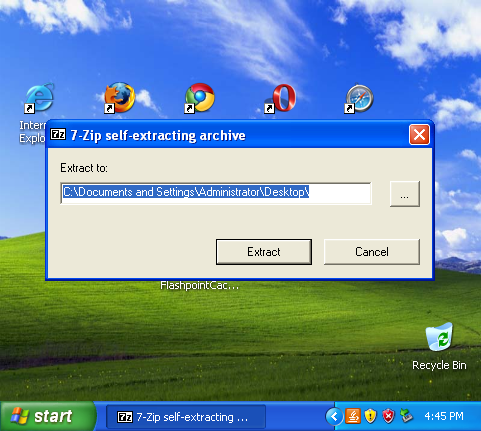
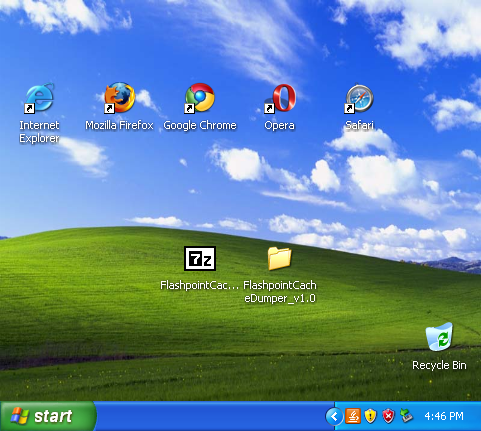
- Navigate to the new folder where the tool was extracted to and run the batch file
FlashpointCacheDumper.bat. A new window will pop up. Be sure to read what it says before pressing Enter to start running the script.
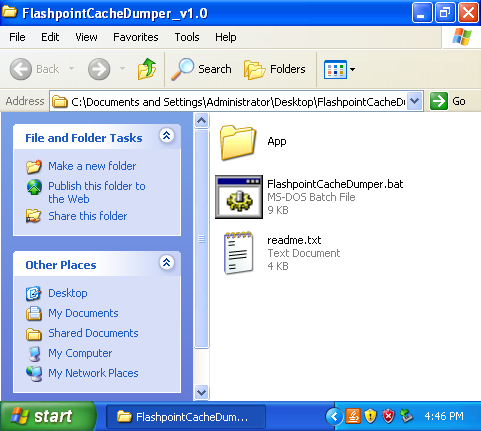
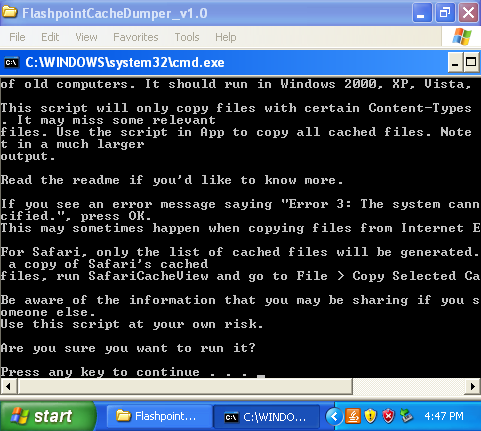
- Let the script run through its 11 steps. After it finishes, press Enter again to close the window. You'll now have two new folders (DumpedCacheInfo and DumpedCache) and two new files (DumpedCacheInfo.7z and DumpedCache.7z).
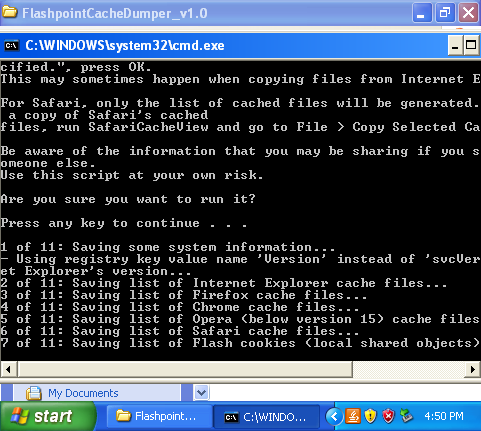
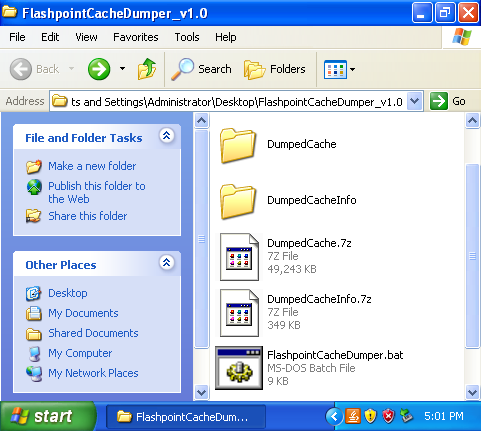
-
The DumpedCacheInfo.7z file contains the list of all your cached files while DumpedCache.7z contains some (but not all) of these files. You can check if DumpedCache contains any game files, or open the CSV files in DumpedCacheInfo to see a list of all the cached files. You may use the lightweight CSV viewer located in
App\csvfileviewto do so.
Alternatively, if you don't know what to do with these files, you can send DumpedCacheInfo.7z first to a staff member. This may be done privately (by messaging them directly) or by posting the file in the#web-cachechannel of our Discord server. You may be asked to send DumpedCache.7z in case you have any files belonging to a lost game. Since this file is larger than the previous one, you can upload it here and post the link in the same channel.
Be aware that whoever you send the resulting files to will be able to see what websites were visited and the username of the computer where the script ran.

Using the complete variant
This section will talk about a variant of the script above which will copy all cached files along with some extra content. If this is your first time running this tool, you can skip this section for now.
The script we ran above only copies cached files if they're in a format that was used by web plugins (like Flash or Shockwave) or if their URLs begin in a certain way (like www.cartoonnetwork.com or www.nabiscoworld.com). Since a web game can use files in any arbitrary format, some game assets may not be copied over. If you want to be thorough, run CompleteFlashpointCacheDumper.bat located in the App folder. This will copy all cached files and place them in a single archive (DumpedCache.7z) which will be much larger than the two we saw above.
Note that both of these scripts always generate a list of all cached files, so you can use these to check if any important game assets weren't copied by FlashpointCacheDumper.bat.
Here are the key features of the two batch files included in this tool:
| Feature | FlashpointCacheDumper.bat | App\CompleteFlashpointCacheDumper.bat |
|---|---|---|
| Lists all cached files | Yes | Yes |
| Lists Flash cookies | Yes | Yes |
| Saves some system information | Yes | Yes |
| Copies all cached files | No, only some (based on MIME type and URL) | Yes |
| Copies the Java Plugin's cache | Yes (to a separate archive) | Yes |
| Copies all of Internet Explorer 6 or older's cache manually | No, only some (to a separate archive and based on file extension) | Yes |
| Copies Netscape Navigator's cache | Yes (to a separate archive) | Yes |
In addition to using NirSoft's IECacheView to list and copy files cached by Internet Explorer, this tool will also do this manually if it detects IE 6 or older. This is because of a bug in these versions where some cached files are left behind even though their respective indexes are deleted by the browser. IECacheView relies on these indexes to find the cached files, meaning we could potentially miss games that were left behind by this bug.
Analyzing the results
After running either of the batch files, you'll have CSV files which list every cached file and a copy of some or all of these. You can now search for missing game assets any way you want.
For example, you can import each CSV file to a spreadsheet program and see all the items that were cached by a specific browser. Starting with version 4, this tool comes with a lightweight CSV viewer, which is located in App\csvfileview. You'll probably want to sort them by Filename, Content-Type or URL, depending on what you're looking for. You can use the section below for reference since it lists some of the MIME types and file extensions that are relevant to Flashpoint.
Note that Shockwave .dcr files may be saved as .dir because of their MIME type. If a game requires an asset called game.dcr, you'll have to look for both that file and game.dir.
After running FlashpointCacheDumper.bat the following files and folders will be created:
-
A folder called DumpedCacheInfo which contains the following files (some may not exist if the respective web browser isn't installed). These files list all the files cached by Internet Explorer, Mozilla Firefox, Google Chrome, Safari, and Opera (below version 15); all Flash cookies; and some system information (Windows version, install date, Internet Explorer's version and cache location).
- ChromeCache.csv
- MozillaCache.csv
- FlashCookies.csv
- InternetExplorerCache.csv
- OperaCache.csv
- RawInternetExplorerCache.csv
- SafariCache.csv
- SystemInfo.txt
- A compressed archive of this folder, called DumpedCacheInfo.7z.
-
A folder called DumpedCache which contains the following folders (some may not exist if the respective web browser isn't installed). These folders contain some (not all) of the files cached by Internet Explorer, Mozilla Firefox, Google Chrome, and Opera (below version 15). Only the cached files which have a certain MIME type or were in a given URL are copied. These MIME types are listed below.
- Chrome
- Mozilla
- InternetExplorer
- Opera
- A compressed archive of this folder, called DumpedCache.7z.
-
A folder called RawJavaPluginCache which contains all the files cached by the Java Plugin. These are separated into the following folders:
- AppData_LocalLow (for Windows Vista or newer)
- ApplicationData (for Windows XP or older)
- LocalSettings_ApplicationData (for Windows XP or older)
- A compressed archive of this folder, called RawJavaPluginCache.7z.
- A folder called RawInternetExplorerCache which contains any files cached by Internet Explorer which have a certain file extension. These file extensions are listed below. This folder is only created if it detects Internet Explorer version 6 or older.
- A compressed archive of this folder, called RawInternetExplorerCache.7z This file is only created if it detects Internet Explorer version 6 or older.
- A folder called RawNetscapeNavigatorCache which contains files cached by Netscape Navigator. Like the Java Plugin folder, these are separated into the various subfolders depending on the browser's version.
- A compressed archive of this folder, called RawNetscapeNavigatorCache.7z.
After running App\CompleteFlashpointCacheDumper.bat, only one folder and compressed archive are created: DumpedCache and DumpedCache.7z. These contain all of the previous information as well as every single cached file, regardless of their MIME type, URL or file extension.
Version history
- Version 7 (2020-04-26):
- Added support for Windows 98 and ME. To run this tool in those versions, use
Win-98-ME-FlashpointCacheDumper.batandWin-98-ME-CompleteFlashpointCacheDumper.batinstead. - Added support for Netscape Navigator 3.x through 9.x. These cached files are saved to
RawNetscapeNavigatorCache.7z. - Updated the README with instructions on how to analyze the resulting files and other ways of exploring the cache.
- The batch files now save more information to
RawInternetExplorerCache.csv(renamed fromRawInternetExplorerCache.txt). This was done by including NirSoft's SearchMyFiles, which is located inApp\searchmyfiles. - Added a new cache viewer called Tim Johnson's Cache View. This tool can be used to load Netscape Navigator's cache, and is located in
App\cview285. - The
SystemInfo.txtfile now also saves which batch file was used, and the date when it ran. - Renamed
ContentTypesToSave.txtandURLsToSave.txttoMimeTypesToSave.txtandWebsitesToSave.txt, respectively. - Added Atomic3D Player and Pulse Player's MIME types and file extensions to
MimeTypesToSave.txtandFileExtensionsToSave.txt. Also added some missing ones for Authorware, Hypercosm 3D Player, Java, Silverlight, Viscape, and VRML. - Added more websites to
WebsitesToSave.txtand categorized any previously unsorted domains. - Fixed the batch files not being able to execute basic commands if the PATH environment variable didn't include Windows' system directories.
- Fixed the Java Plugin Cache Exporter incorrectly showing cached files with no URLs associated with them.
- Added support for Windows 98 and ME. To run this tool in those versions, use
- Version 6 (2020-02-24):
- Added a batch file (
JavaPluginCacheExporter.bat) that makes it easier to run the Java Plugin Cache Exporter. The Java version it uses to run can be optionally defined in the configuration filejre-path.cfg. - Renamed the output directory
JavaPluginCacheto:RawJavaPluginCache(forFlashpointCacheDumper.bat) andExportedJavaPluginCache(for the Java Plugin Cache Exporter). - The CSV generated by the Java Plugin Cache Exporter is now saved in the same directory as the exported files.
- Added Nirsoft's JRView to make it easier to view all the installed Java Runtime Environments and Java Development Kits. This tool is located in
App\jrview. - Updated NirSoft's MozillaCacheView, ChromeCacheView, and CSVFileView.
- Added a version file. The tool's version is now saved to
SystemInfo.txt. - Added two Pogo.com subdomains to
URLsToSave.txt.
- Added a batch file (
- Version 5 (2020-02-17):
FlashpointCacheDumper.batnow saves the Java Plugin cache toJavaPluginCache.7z.FlashpointCacheDumper.batnow saves files cached by Internet Explorer 6 or older toRawInternetExplorerCache.7z, if they have a file extension specified inFileExtensionsToSave.txt.
- Version 4 (2020-02-07):
- Created a small Java application that exports any files cached by the Java Plugin from a given directory. The exported files are organized according to their original website structure. It also generates a CSV file that lists every cached file and some additional information (Content-Type, URL, Last Access Date, etc). This tool is located in
App\JavaPluginCacheExporter. - Added NirSoft's CSVFileView to make it easier to view the resulting CSV files. This tool is located in
App\csvfileview. - Fixed a bug that prevented both batch files from saving system information on Windows 2000 and non-professional editions of Windows XP:
- Fixed a bug that prevented both batch files from querying the registry on Windows 2000.
- Created a small Java application that exports any files cached by the Java Plugin from a given directory. The exported files are organized according to their original website structure. It also generates a CSV file that lists every cached file and some additional information (Content-Type, URL, Last Access Date, etc). This tool is located in
- Version 3 (2019-12-14):
- Both batch files save a list with every file in IE's cache directory to
RawInternetExplorerCache.txtif it detects version 6 or older. - Both batch files delete any pre-existing cache dump folders and archives before running.
- Added ShiVa3D's MIME type to
App\ContentTypesToSave.txtand three Postopia subdomains toApp\URLsToSave.txt. - There's now a script called
TestBatch.batin the App folder which can be used to check if batch files work on your computer.
- Both batch files save a list with every file in IE's cache directory to
- Version 2 (2019-12-03):
CompleteFlashpointCacheDumper.batnow copies IE's cache directory manually for version 6 or older (and not just for version 6).
- Version 1.0 (2019-11-30):
- Initial release.
Other useful tools and resources
This section will link to other tools and resources that may be useful when looking for lost game files in browser cache.
- NirSoft's Web Browser Tools, specifically the cache viewers for Internet Explorer, Mozilla Firefox, Google Chrome, Opera and Safari. These tools are already used by the Flashpoint Cache Dumper, so you can also run them directly instead of using the script.
- Search Everything, a tool that can quickly locate files and folders by filename on Windows. Allows you to use various filters which can help track down specific types of files in certain locations. Useful if you're searching for cached web game files without using the Flashpoint Cache Dumper or NirSoft's cache viewers.
Cache locations
This section will list the location of the web cache in various browsers and operating systems. This is useful if you want to search for cached files manually without using the Flashpoint Cache Dumper. Note that you can still use NirSoft's cache viewers by changing the directory they process.
Internet Explorer
If you use the Flashpoint Cache Dumper, this location is automatically saved in SystemInfo.txt.
| Operating System | Cache Location |
|---|---|
| Windows 95, Windows 98, Windows ME | %WINDIR%\Temporary Internet Files |
| Windows 2000, Windows XP | %USERPROFILE%\Local Settings\Temporary Internet Files |
| Windows Vista, Windows 7 | %USERPROFILE%\AppData\Local\Microsoft\Windows\Temporary Internet Files |
| Windows 8, Windows 8.1, Windows 10 | %USERPROFILE%\AppData\Local\Microsoft\Windows\INetCache |
| Windows 8, Windows 8.1, Windows 10 (Enhanced Protected Mode) | %USERPROFILE%\AppData\Local\Packages\windows_ie_ac_001\AC\INetCache |
Java Plugin
| Operating System | Cache Location |
|---|---|
| Windows 98, Windows ME | %WINDIR%\Application Data\Sun\Java\Deployment\cache |
| Windows 2000, Windows XP | %APPDATA%\Sun\Java\Deployment\cache |
| Windows Vista, Windows 7, Windows 8, Windows 8.1, Windows 10 | %USERPROFILE%\AppData\LocalLow\Sun\Java\Deployment\cache |
MIME types and file extensions
This section will list the MIME types and file extensions that FlashpointCacheDumper.bat uses to determine whether or not it should copy a cached file. These are defined in both App\MimeTypesToSave.txt and App\FileExtensionsToSave.txt.
| Technology | MIME Types | File Extensions |
|---|---|---|
| 3D Groove GX | - | .grv |
| Atomic3D Player | video/x-atomic3d-feature application/x-atomic3d |
.fmf .psq .agp .agt .seq .scn |
| Authorware | application/x-authorware-bin application/x-authorware-map application/x-authorware-seg |
.aab .aam .aas |
| Burster | application/x-burster | .blend .blendz |
| Cabinet Files | application/vnd.ms-cab-compressed | .cab |
| Cult3D | application/x-cult3d-object | .co |
| Flash | application/x-shockwave-flash application/vnd.adobe.flash-movie application/futuresplash |
.swf .spl |
| Hypercosm 3D Player | application/x-hypercosm application/x-Hypercosm-3D-Applet |
.hcvm |
| iPIX | application/photobubble application/pbautomation application/x-ipix application/x-ipscript |
.bub .aut .ipx .ips |
| Java | application/java-archive application/java-serialized-object application/java-vm application/x-java-applet application/x-java-bean application/x-java-vm application/x-java-vm-npruntime application/x-java-jnlp-file |
.jar .ser .class .jnlp |
| Pulse Player | application/x-pulse-player application/x-pulse-player-32 application/x-pulse-stream application/x-pulse-download application/x-pulse-version |
.pwc .pw3 .pws .pwn .pwv .pwr |
| ShiVa3D | application/x-shiva3d | .stk |
| Shockwave | application/x-director | .dir .dxr .dcr .cst .cxt .cct .swa .w3d |
| Silverlight | application/x-silverlight-app application/x-silverlight application/x-silverlight-2 |
.xap .scr |
| Unity | application/vnd.unity | .unity3d |
| Virtools / 3D Life Player / 3DVIA Player | application/x-virtools application/x-nemo |
.cmo .vmo .nmo .nms |
| Viscape | x-world/x-vrt x-world/x-svr x-world/x-xvr application/vnd.superscape.vislite |
.vrt .svr .xvr .ssv |
| Vitalize! | application/x-cnc application/x-tgf |
.ccn |
| VRML | model/vrml x-world/x-vrml application/x-vrml application/x-bscontact application/x-blaxxuncc3d application/x-blaxxuncc3dpro application/x-cc3d |
.wrl .wrz .wrl.gz .vrml .bswrl .bxwrl |
| X3D | model/x3d model/x3d+xml model/x3d+binary model/x3d+vrml model/x3d+zip |
.x3d .x3dv .x3db .x3dz .x3dvz .x3dbz .x3z |















